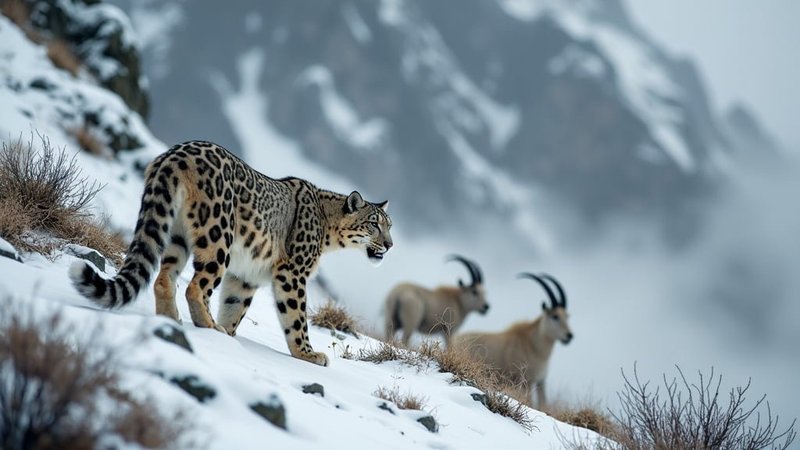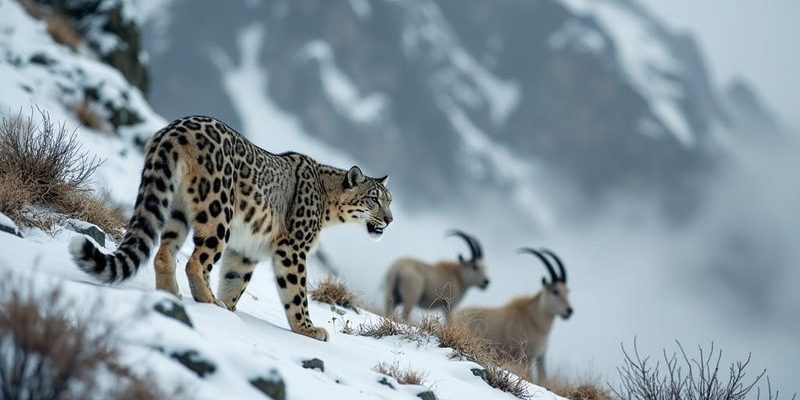
Snow leopards primarily thrive in high-altitude areas, where steep cliffs and rocky outcrops provide security and stealth. But what do they eat, and how do they catch their meals? Picture a skilled hunter—silent, patient, and calculating. That’s exactly how a snow leopard operates. Let me explain how their diet works and the hunting tactics they master to catch prey.
Understanding the Diet of Snow Leopards
One of the many things that sets snow leopards apart is their diet. They are carnivores, which means they primarily eat meat. Their prey includes various animals adapted to the rough terrain, such as ibex, bharal (also known as blue sheep), and sometimes even small mammals like marmots. Here’s the thing: these cats are opportunistic hunters, which means they’ll take advantage of whatever prey is available.
- Ibex: These are large, wild goats that snow leopards commonly hunt. They are agile and can navigate steep cliffs, but the snow leopard’s stealth gives it an edge.
- Bharal: Similar to ibex, bharal live in rocky areas and often graze on grasses. Snow leopards target these animals because they’re abundant in their habitat.
- Small mammals: When larger prey isn’t around, snow leopards might feast on smaller creatures like marmots, providing them with necessary nutrients.
You might be wondering how snow leopards manage to hunt prey that is often much larger than them. Their adaptations play a crucial role in this. Strong legs and immense lung capacity allow them to leap across great distances and climb steep slopes with ease, while their thick fur keeps them warm in freezing temperatures.
Hunting Techniques and Strategies
Now that we have a grasp on what they eat, let’s talk about how snow leopards catch their food. Their hunting strategy can be likened to playing a game of chess—every move is planned and requires patience. Snow leopards utilize a combination of stealth and surprise to outmaneuver their prey.
First off, they rely heavily on camouflage. With their beautiful grey fur patterned with black rosettes, snow leopards can effortlessly blend into their rocky surroundings. This ability to hide is crucial. They will often stalk their prey from a distance, moving slowly and quietly. When they get within striking distance, they’ll make a quick, powerful leap to capture their meal.
Another important tactic is their stalking behavior. They tend to approach their prey from above or around, taking advantage of the terrain. Here’s a little story to paint a picture: Imagine a snow leopard crouched low behind a boulder, its keen eyes fixed on a grazing bharal below. It remains completely still, barely even breathing, waiting for the perfect moment to pounce.
Time of Day Matters: When Snow Leopards Hunt
You may not have thought about it, but the time of day greatly impacts snow leopards’ hunting success. Snow leopards are primarily crepuscular, which means they’re most active during dawn and dusk. Why? The low light conditions provide a tactical advantage, giving them the element of surprise while also allowing them to navigate their rugged environment more easily.
During these twilight hours, the landscape is quieter, and many animals are out searching for food. This is when a snow leopard’s stealth truly shines. It’s like attending a dance where few people are on the floor. The snow leopard moves gracefully, darting silently in the shadows, ready to seize the moment.
Importance of Territory in Hunting
Just like we have our favorite spots to hang out, snow leopards have defined territories that they roam. Each leopard has a home range that can stretch across many miles, depending on the abundance of prey. Here’s the thing: maintaining a territory is vital for ensuring access to food.
Typically, male snow leopards will have larger territories than females. This is partly because they need to attract a mate and, quite frankly, be the king of their domain. A well-maintained territory means they can hunt effectively without having to compete too much with others. And honestly, finding a good spot with plenty of prey can mean the difference between life and death.
Seasonal Variations in Diet
As seasons change, so do the dynamics of hunting and diet for snow leopards. During the winter months, their preferred prey may be less available due to heavy snow or migration patterns. This is when snow leopards might adapt their diet further, hunting smaller animals that are easier to catch in more challenging conditions.
In the spring, however, the melting snow usually brings an influx of shifting populations of ibex and bharal, giving snow leopards a chance to feast again. You might think of it as a buffet suddenly opening up after a long winter of waiting. The snow leopard’s ability to adapt to these seasonal changes is one of the reasons it thrives in such harsh environments.
Challenges Faced by Snow Leopards in Hunting
Snow leopards face numerous challenges when it comes to hunting and obtaining food. Aside from the sheer difficulty of catching elusive prey, they contend with environmental changes and habitat loss. Human encroachment on their territories—like farming and urban development—poses a significant threat.
As a result, dwindling prey populations can make finding food increasingly difficult. Additionally, climate change affects the snow leopard’s habitat, as rising temperatures may lead to shifts in where their preferred prey lives. In this ever-changing landscape, it’s a real struggle, and conservation efforts are crucial to help these magnificent cats thrive.
The Balance of Nature: Snow Leopards as Predators
Snow leopards play a vital role in their ecosystem as top predators. By keeping herbivore populations in check, they help maintain a healthy balance in their environment. Without the snow leopard, the population of prey animals could grow unchecked, leading to overgrazing and habitat degradation.
This balance is crucial for the overall health of the ecosystem. So, when you think about snow leopards and their hunting strategies, realize that they’re not just magnificent creatures; they’re essential to the landscape they inhabit.
In conclusion, snow leopards have honed remarkable skills in both their diet and hunting strategies. From their stealthy stalking to their adaptation to local environments, they’re fascinating creatures worth studying and protecting. By understanding their behaviors, we can better appreciate the struggles they face and the need for conservation efforts. So next time you hear about the snow leopard, think of them not just as beautiful animals, but also as vital players in our planet’s ecosystem.

